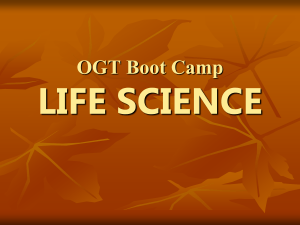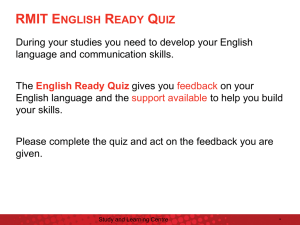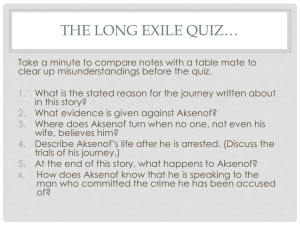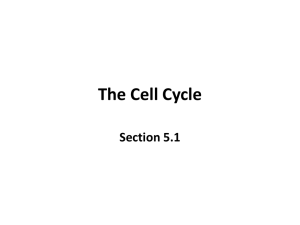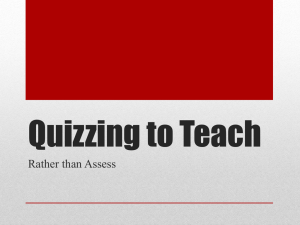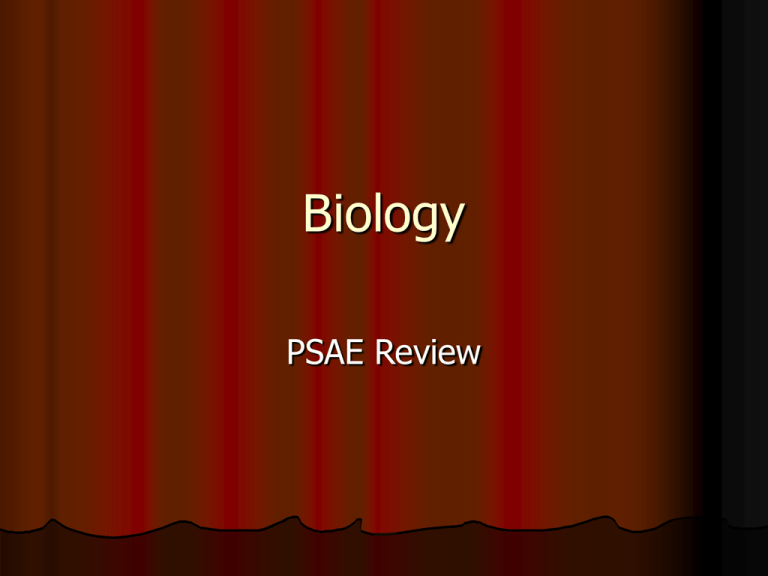
Biology
PSAE Review
Today’s Goals
Feel good about what you have learned
It’s
more than you think!
Brush-up on some science skills
Perform well on the PSAE…
Exempt
from senior finals!
Topics
Scientific Method
Biochemistry
Cells!!!
Genetics
Evolution
Biodiversity
Quiz #1
Scientific Method
1.
2.
3.
4.
5.
An educated guess is called…
A variable in an experiment that is controlled
and changed by the scientist is called…
True or False: One experiment is good.
enough to get accurate results
Name a lab instrument used to measure
volume
In an experiment, there is a experimental
group and…
Question #1
An educated guess is called…
Hypothesis
You don’t have to be right
Scientists are often wrong
Question #2
A variable in an experiment that is
controlled and changed by the scientist
is called…
Independent variable
Dependent variable
Changes on its own in response to the
independent variable
Is measured
Graphing
Question #3
True or False: One experiment is good
enough to get accurate results.
FALSE
Many repeats needed for valid results
Question #4
Name a lab instrument used to measure
volume.
Beaker / Flask
Graduated Cylinder
Ruler (if it’s a solid)
Question #5
In a experiment, there is a experimental
group and…
Control Group
Receives NO treatment / change
Natural conditions
Imagine an experiment testing the
effectiveness of a new cancer drug
Quiz #2
Biochemistry
1.
2.
3.
4.
5.
Carbohydrates are also known as…
Lipids are also known as…
Name a protein found in/on your body.
Name the famous nucleic acid found in
every cell.
Which element does every molecule
listed above have in common?
Question #1: Carbohydrates
Sugar!
Question #2: Lipids
Fats, oils, waxes, steroids, cholesterol
Question #3: Protein
Amino acids
Make your body function
Enzymes
Question #4: Nucleic Acids
DNA and RNA
Question #5: Elements
Carbon is the basic element for all living
things
Also N, O, P, H
Quiz #3
Cells
1.
2.
3.
4.
5.
Name a difference between prokaryotes
and eukaryotes.
Where is DNA found in the cell?
Name two structures found only in plant
cells
Which cell parts make cell energy?
When things diffuse, do they move from
high to low or low to high?
Question #1: Pro v. Euk
Prokaryote
No nucleus
Unicellular
Example: Bacteria
Eukaryote
Nucleus
Complex organelles
Uni or multicellular
Example: Us!
Question #2: The nucleus
DNA is found in the nucleus
Brain
of the cell - instructions
Questions #3: Plant v. Animal
Organelles
Cell membrane – controls
what goes in and out
ER – tubes for transport
Lysosome – digestive
enzymes
Vacuole – temp. storage
Mitochondria – energy!
Golgi – repackage stuff
Cytoplasm - fluid
Question #4: Cell Energy
Responsible organelles
Animal
cell – mitochondria
Plant cell – chloroplast
It’s all about ATP
Make
it or break it
Photosynthesis
Make sugar for plants
Chlorophyll and
chloroplasts
2 Part Process:
Light reactions – ATP
is made
Calvin cycle – sugar is
made
Light Reactions
Calvin Cycle
AKA Light Independent
AKA Dark Reactions
Respiration
Food broken down to release energy
Mitochondria
Photosynthesis vs. Respiration
Photosynthesis
Food synthesized
Respiration
Food broken down
Energy from sun stored in glucose Energy from glucose released
Carbon dioxide taken in
Carbon dioxide given off
Oxygen given off
Oxygen taken in
Requires light
Does not require light
Chloroplast
Mitochondria & Cytoplasm
Plant cells only
All living cells
Question #5: Diffusion & Osmosis
The movement of particles from high to
low concentration
Osmosis = water only
Cell membrane responsible
Semi-permeable
Want to achieve homeostasis
Cell Membrane
Osmosis
Quiz #4
Cell Division
1.
2.
3.
What does DNA stand for?
Contrast chromosome and chromatin.
What are the stages of the cell cycle?
4.
5.
Remember IPMAT
What is mitosis?
How is meiosis different from mitosis?
Questions #1: DNA
Deoxyribonucleic Acid
Contain genetic info
Nucleus
Makes protein
Made of
Sugar
Phosphate
Base
Question #2: Chrom…?
Chromatin
Chromosome
Uncoiled – loose DNA
Coiled
Most of the time
Question #3: Cell Cycle
Growth and division of cells
IPMAT
Interphase
Prophase
Metaphase
Anaphase
Telophase
– 80% of the time – DNA copies
Cell Cycle
Question #4: Mitosis
Make identical copies of a cell
Actual dividing
Question #5: Meiosis
Mitosis – somatic cells
Meiosis – makes sex cells (sperm & egg)
AKA
gametes
Have a half-set of chromosomes (haploid)
2 cell divisions
Makes 4 cells
Same phases IPMATPMAT
Mitosis v. Meiosis
Mitosis
1 cell division
Daughter cells
identical to parents
cells
Produces 2 cells
2n → 2n
Produces cells for
growth and repair
No crossing over
Meiosis
2 cell divisions
Daughter cells
different from parents
Produces 4 cells
2n → 1n
Produces gametes
Crossing over
Quiz #5
Genetics
1.
2.
3.
4.
5.
Who is the father of modern genetics?
What is the difference between dominant
and recessive traits?
AA: Homozygous or heterozygous?
How many boxes does a monohybrid
Punnett Square have?
What is a pedigree?
Question #1: Father…
Gregor Mendel
Pea Plants
Knew about genes
Knew about alleles
Alternative
form of genes
Ex: brown eyes and blue eyes
Question #2: Dominant v. Recessive
Dominant traits
Trait
that covers up another trait when
present
CAPITAL LETTER
Recessive
Trait
that is covered
lowercase letter
Question #3: Homo v. Hetero
Each person inherits 2 alleles
AA = homozygous dominant
aa = homozygous recessive
Aa = heterozygous
Question #4: Punnett Squares
http://www.execulink.com/~ekimmel/punnett_square.swf
Question #5: Pedigree
Pedigree
Quiz #6
Evolution
1.
2.
3.
4.
5.
Who traveled to the Galapagos and
discovered natural selection?
How do we get a new species?
True or False: Evolution has a goal.
Name an adaptation of birds.
True or False: We believe in
spontaneous generation.
Question #1: Galapagos
Charles Darwin
Great diversity of life
Saw change over time
Question #2: New Species
Speciation
Happens
because of
mutations
Benefit
survival in
environment
Geographic
isolation
Question #3: Goal?
There is NO goal to
evolution
Question #4: Adaptation
Increase the likelihood of survival and
reproduction
Mimicry
Camouflage
Question #5: We believe…
In BIOGENESIS
Spontaneous Generation disproved
Francesco Redi
Quiz #7
Biodiversity
1.
2.
3.
4.
5.
How many kingdoms of living things are
there?
Finish this…Kingdom, phylum, class,
order…
What is the scientific name of humans?
Is a virus living or nonliving?
When would you use a dichotomous
key?
Question #1: Kingdoms
There are 6
Archaebacteria
Eubacteria
Protist
Fungi
Plant
Animal
Question #2:
Kingdom
Phylum
Class
Order
Family
Genus
Species
Cladogram & Phylogenetic Tree
Phylogenetic Tree
Question #3: Scientific Names
Homo sapien
Written as Genus species
Question #4: Virus?
Not quite living
Does not grow or
move on its own
Needs a host
Not a cell
Ex: Bacteriophage
Attacks bacteria
Question #5: Dichotomous Key
Used to identify organisms by name
“Choose Your Own Adventure” books
Quiz #8
Ecology
1.
2.
3.
4.
5.
Give an example of a producer and
consumer.
What is an omnivore?
In the water cycle, are clouds
condensation or precipitation?
If a population grows exponential, what
would the graph look like?
Name a gas that causes global warming.
Question #1: Who eats whom?
Question #2: Omnivore
Producers – autotrophs – plants
Consumers – heterotrophs
Herbivore
– eats plants
Carnivore – eats animals
Omnivore – eats a variety
Decomposer – fungi & bacteria
Biomass Pyramid
Food Webs
Question #3: The Cycles
3 cycles keep the earth balanced:
Water
Cycle
Carbon-Oxygen Cycle
1. Evaporation
2. Condensation
3. Precipitation
4. Collection /
Runoff
Oxygen-Carbon Cycle
Release O2
Release CO2
Photosynthesis
Take in CO2
Eating plants provides
carbohydrates
Question #4: Populations
All the members of one species in a
particular area
Density
- # in a specific area
Patterns
Population Growth
Exponential
Rate
increases faster
as time goes on
J-shaped curve
Population Growth
Logistic Growth
Environment
limits
Reaches carrying capacity
S-shaped curve
Question #5: Global Warming
Just kidding…
Global Warming
Greenhouse Effect
Heat
from the sun in not able to escape the
atmosphere due to the abundance of gases
Carbon dioxide CO2
CFC (chlorofluorocarbons)
Methane
Nitrous Oxide






